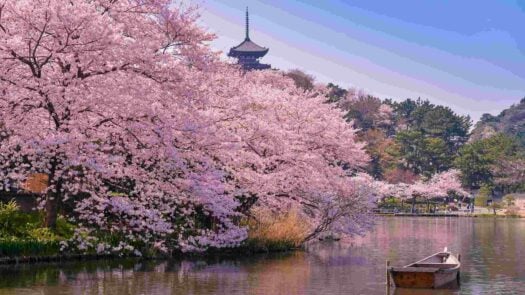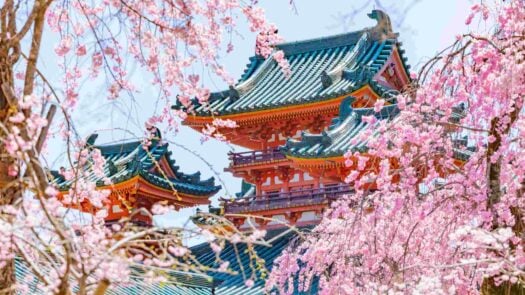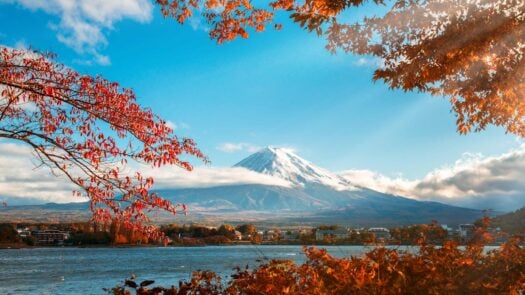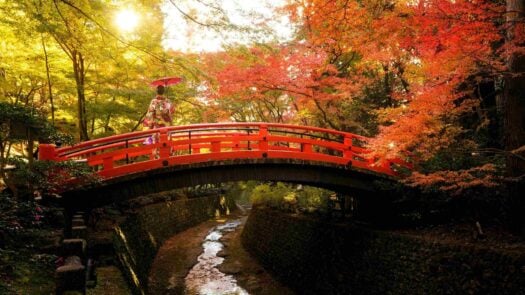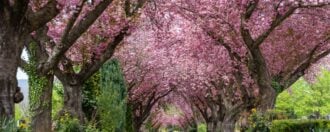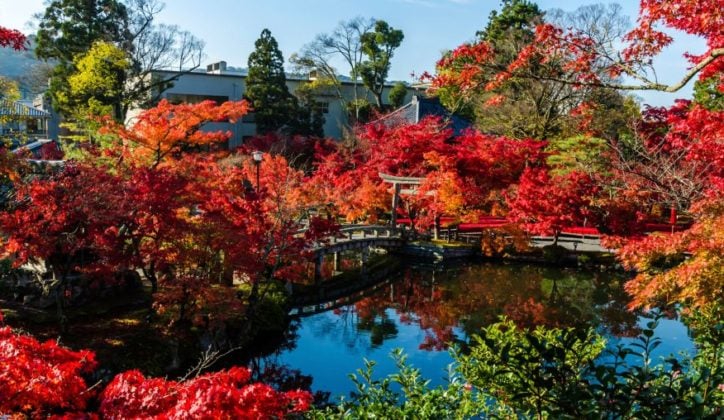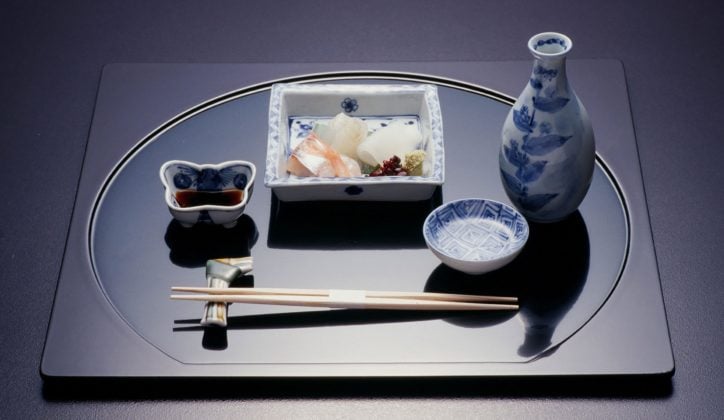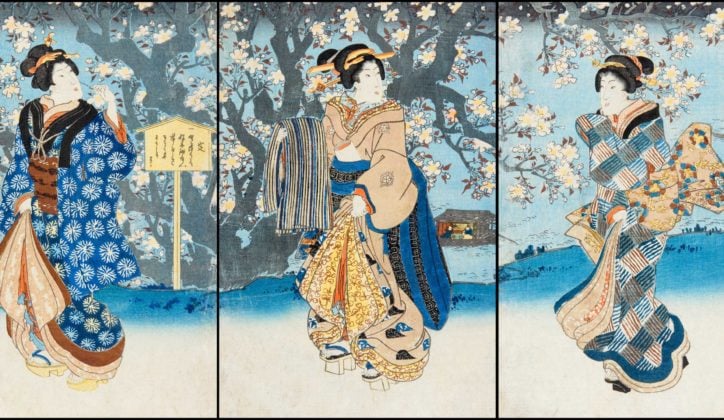Published on: April 28th, 2024
Last updated: April 29th, 2024
As a truly year-round destination, the best time to visit Japan depends on what you want to do there.
The most popular times to go are spring (end of March to mid-April), when the cherry blossoms are in bloom, or autumn (November to early December), when the autumn leaves put on another spectacular colour show. But since these times attract the most tourists, you might consider going at another time so if you prefer to avoid the crowds.
Japan has four distinct seasons and is a long and skinny country, stretched out across four main islands (and some remote smaller islands too), so the weather varies from place to place. The warm summer runs from June to September when temperatures in Tokyo can exceed 31°C (88°F), and the mercury can creep towards 35°C (95°F) on the subtropical island of Okinawa.
In contrast, the winters (December to early March) can be bitterly cold. The far-reaching northern island of Hokkaido will see plenty of snow, making Japan famous for its winter activities. Tokyo’s morning temperature will drop down to 5ºC (41°F) and there can even be a light snow covering for a few days each winter.
Japan’s rainy season starts in mid June and can run until September. On Japan’s main island, Honshu Island, June is the rainiest month. July and August experience humidity and occasional showers, producing verdant, stunning ornate gardens. By November the rains in Tokyo are clearing up and December to February and the driest months.
Japan is a diverse country with many incredible highlights. There’s the towering natural wonder of Mount Fuji and the pretty town of Hakone that sits within the Fuji-Hakone-Izu National Park at the mountain's base. There’s the cultural hub of Kanazawa, brimming with Geisha history and Hiroshima and Miyajima Island, a must-do destination for those interested in Japan’s past.
Monthly Climate Guide for Japan
Japan is essentially a year round destination – there’s always a good time to be somewhere in this vast and varied country. There are so many different kinds of landscapes and environments to consider, along wtih seasonality.
To help you plan the best time to visit Japan, we’ve put together a month by month climate guide. We’ll let you know what the weather will be like in some of our favourite areas and mention the seasonal highlights too.
January in Japan
Best for snow activities
A cold winter month where snow falls across the north of the country – perfect for snow activities and popular with both local and international ski and snowboarding crowds. It’s possible to see a few days of snow in Tokyo in January, however average midday temperatures stay close to 10°C (50°F) in the capital.
February in Japan
Best for snow sculptures
In the north it is still very much winter and is the peak season for snow resorts. The world renowned Sapporo Snow Festival takes place in February – where huge snow sculptures are built in Odori Park. Across the southern parts of the country the spring season is beginning and Okinwa will welcome the first of the cherry blossoms. Temperatures in Tokyo remain similarly to January, around 10°C (50°F).
March in Japan
Best for Cherry Blossom
March is officially the start of spring. Famous worldwide for hanami (cherry-blossom viewing), spring in Japan could well be one of the most romantic sights you’ll ever see. Keep in mind that this is also one of the busiest times for tourists in Japan. The weather feels warmer after the cold winter, although in Tokyo you will still need a warm jacket with temperatures of around 13°C (55°F). However in Okinawa it’s warmer at around 20°C (68°F).
April in Japan
Best for warmer temperatures and pretty blossoms
The temperatures are continuing to creep up and April is the best month to see cherry blossoms across the country. Kyoto’s sites such as Silver Pagoda, Philosopher’s Walk and Nanzenji Temple are particularly beautiful at this time of year as they are framed by the soft pink blossoms. In Tokyo it’s starting to feel warm with midday temperatures reaching 19°C (66°F).
May in Japan
Best for Golden Week festivities
May is a very pleasant time of year, temperatures are warm but not yet too hot to be stifling. Japan’s Golden Week takes place at the start of May with almost all of Japan’s residents taking this time as a holiday. Tokyo, Osaka and Kyoto can feel very busy in May with a bustling and jubilant atmosphere, and temperatures are now around 22°C (73°F). The southern regions, such as Okinwa are now starting to experience the rainy season.
June in Japan
Best to see beautiful gardens
June is humid with increased rainfall across Japan, however the showers tend to fall sporadically, interspersed with sunshine, Tokyo will reach around 25°C (77°F). The rainy season, or tsuyu (plum rain), usually starts in mid-june and will last on and off until October. These conditions create wonderful lush green gardens. This is a spectacular time of year to visit any of Japan’s ornate gardens such as Kenrokuen Garden in Kanazawa.
July in Japan
Best for hiking on Mount Fuji
July is another hot month, around 29°C (84°F) in Tokyo, with some rain. The hot temperatures mean that retreating to the mountains for cooler air is a good idea and hikes on the higher trails of Mount Fuji are pleasant at this time of year. Most places like shopping malls and restaurants in Japan are air conditioned, so the heat is still manageable.
August in Japan
Best for Natsu Matsuri (summer festivals)
August is peak summer and often the hottest month of the year. In Tokyo, Osaka and Kyoto temperatures can exceed 31°C (88°F). August is also a month of many Natsu Matsuri (summer festivals) taking place across the country. Awa Odori Matsuri in Tokushima on Shikoku island is an enormous and vibrant dance festival and the Obon holiday (13th-15th August) is a Buddhist event that commemorates ancestors whose spirits return to visit relatives at this time.
September in Japan
Best for the start of autumn leaves and quieter travels
September can be a wonderful month to travel to Japan as the school-holiday crowds disperse and the weather stays warm at around 27°C (81°F) on Honshu. Areas such as Osaka and Kyoto typically boast plenty of clear skies, with some brief showers. By the end of the month spectacular autumnal leaves are starting to make an appearance. Hakone and the Mount Fuji area are particularly beautiful at this time of year.
October in Japan
Best for the last of the warm days and autumn leaves
October is the start of autumn and the temperatures begin to drop. The best time to visit Japan is the fall as it’s a great time to see the stunning reds, oranges and yellows of Japan’s autumn leaves. The days can still feel warm in some places. In the major cities such as Tokyo, Kyoto and Osaka expect day time temperatures in the low 20s C (70s F) with chilly nights and mornings.
November in Japan
Best time to visit Tokyo
November is an autumn month with cool temperatures. In northern Hokkaido most of the autumn leaves have finished as the region transitions into winter. Further south, many would argue that November is the best time to go to Tokyo to see the city framed by beautiful orange, yellow and red autumn leaves, known as koyo. Day time temperatures stay moderate and comfortable at 16°C (61°F). November is a peak time – something to consider if you’re not a fan of crowds.
December in Japan
Best for winter celebrations
December is the start of winter across the entire country of Japan and although temperatures are cooler, the skies usually stay clear and blue. Small bars and restaurants are full of atmosphere and end of year celebrations. Temperatures in Tokyo during the day tend to stay around 12°C (54°F) but the mornings feel chilly at 2ºC (35°F). Many places are closed from the end of December until a few days into January – although you can still visit most temples and shrines, as well as enjoying the great outdoors.
The Best Things to do in Japan by Season
Choosing the best time to go to Japan will depend on the sorts of activities you want to do, what you’d like to see and the places you’d like to visit. Seasonality will also be something to consider, so to help you plan your trip we’ve compiled a list of our favourite things to do and the best time to do them.
See the Cherry Blossoms
The spring season between March to April is the best time to visit Japan for the cherry blossoms . This period marks the end of winter. Depending on weather conditions, the sakura season can last for a few days, up to a couple of weeks. This is also the peak season in Japan.
Keep in mind that the sakura bloom schedules can vary year-to-year, depending on temperature, and how long it lasts is a matter of luck – some years the blossoms might stay on the trees for a couple of weeks, while other times they could be felled early by strong wind or rain.
Cherry blossoms usually only bloom for around one week per location, and at slightly different times throughout the country – starting from Okinawa in early-February and moving northward to northern Hokkaido until late-May. Travel south to north to see them for longer, and check out this article to find out the best places to see cherry blossom in Japan.
See the Autumn Leaves
The best time to visit Japan to see the autumn leaves is between November to December. In areas like Hokkaido, the autumn season begins as early as mid-September while Tokyo and Kyoto see orange leaves as from mid-October.
A visit to Japan when the leaves are changing colour is really spectacular. In fact, we think it's one of the best places to spend autumn in Asia – and, thankfully, the autumn leaves tend to stick around for a bit longer than the cherry blossoms.
By late September, the leaves start changing in the north around the mountains, gradually making their way down to the central and southern cities (Kyoto, Osaka and Tokyo) by mid-October and remaining colourful into early December. Bear in mind that the autumn colours tend to peak a bit later than other places in the northern hemisphere, with the most spectacular displays often reserved for the end of November and even the beginning of December.
Autumn is the second busiest time of year to visit Japan, so it’s best to book your trip way in advance.
Experience Festival Culture
The best time to travel to Japan to enjoy events and festivals is during the summer months between June to mid-September. While it can get quite humid throughout this period, you get to catch a glimpse of the local culture. This is a great time to visit Japan to skip the crowds.
Summertime brings with it many of Japan’s best festivals (or 'matsuri) – including Kyoto’s Gion Matsuri, Osaka’s Tenjin Matsuri, Aomori’s Nebuta Matsuri, and the Awa Odori festival in Tokushima on the island of Shikoku.
This season is also renowned for dazzling fireworks displays, or 'hanabi taikai'. Tokyo’s Sumida River Fireworks are particularly deserving of a mention, but there are plenty of events throughout the country.
See the Snow Monkeys at Jigokudani
If you’d like to see some of Japan’s resident wildlife, then consider a trip to the Snow Monkey Park in the winter. December and January are the best months to visit Jigokudani to witness the many Japanese macaques warming up in the naturally warm waters.
Natural hot springs shroud the park in steam, and it’s this steaming hot appearance that got the park the moniker, Jigokudani, meaning 'hell valley'. However, this is far from true for the monkeys who retreat to the heavenly hot water to warm themselves over the long winter months.
These monkeys are native to Japan and although they do visit the park all year, there is something incredible about witnessing the steaming waters shrouding families of monkeys with a backdrop of brilliant white snow.
Go Skiing and Snowboarding
Late-December to March is the best time to visit Japan for snow activities like skiing and snowboarding. The best months to travel to Japan for its winter festivals are January and February. Occasional snowfall is expected between March and April.
Japan's ski season runs as late as May in some areas, although the best time to hit the slopes depends where you're going.
Snow usually arrives mid-November on the north island of Hokkaido, with the earliest resorts opening during the third week of that month – Niseko, Rusutsu and Kiroro are usually the first of the big resorts to welcome skiers and boarders.
March and April are great for both in-resort and backcountry snow sports. The plentiful early-season snow ensures resort conditions are excellent right until the end of the season and, at this time, the clear weather affords stunning views.
Winter activities
The best time to visit Japan to see Mount Fuji is during late autumn to early spring, throughout the months of November to February. This period sees clear skies and fewer clouds. Early mornings are when you get to enjoy unobstructed views of Mount Fuji.
During these months you can also catch a glimpse of the cherry blossoms or autumn leaves in Japan. The best place to see Mount Fuji is at Lake Kawaguchi.
Keep in mind that between April and August, the mountain can be hidden behind clouds and haze, while typhoon season begins in September. This means that your chances of spotting Mount Fuji are significantly lower.
Trip Inspiration
Where to Stay in Japan
Whatever you want from your adventure in Japan, our team of expert travel designers are ready to help.





